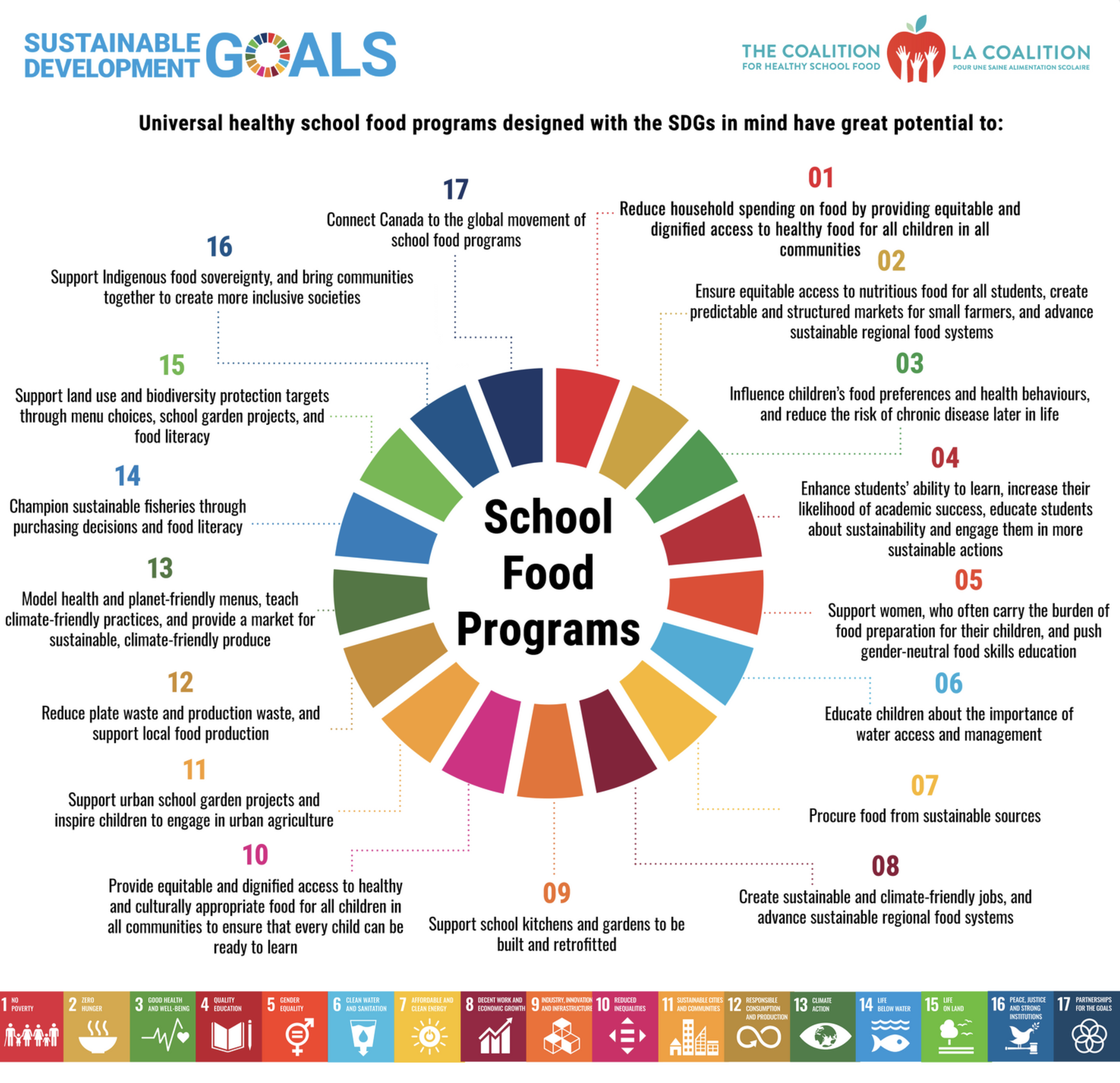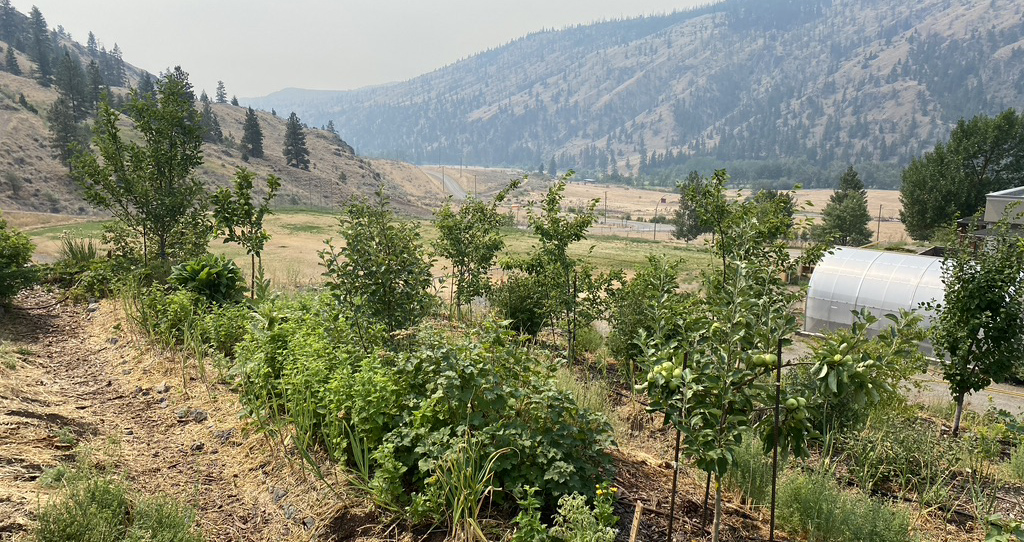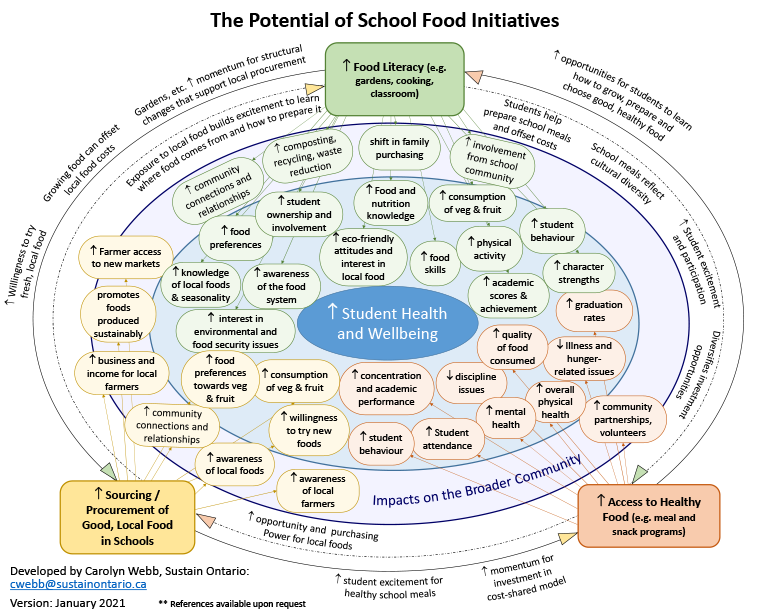Photo: Skeetchestn Community School garden, Kamloops, BC
At Farm to Cafeteria Canada, we’ve been thinking a lot about the role that school food programs can play in climate action.
After all, the way that food is handled all along the food supply chain impacts our energy, water and land use, greenhouse gas emissions, and soil quality.
The EAT-Lancet Commission has said that food is the single strongest lever to optimize human health and environmental sustainability. Food Tank recently published a blog post on how climate action can start with each meal.
Well, what impact do schools have in all of this?
We know from gathering evidence that the Farm to School Approach supports public health, education, community economic development, community connectedness, and the environment.
We also know that these outcomes don’t operate in silos, and when we support the health of students through intentional decisions—whether that be through food procurement or curriculum design—we can better support the health of people and planet all at once.
And we’ve seen firsthand how farm to school programs can support a healthy environment — through the way we eat, the way we think, and the way we act.
The Way We Eat
Students aren’t the ones making food procurement decisions for their meal services, school cafeterias or nutrition programs, so those who are making these decisions have an important responsibility. Fortunately, we can choose to serve food in schools that nourishes young people and supports farmers and other local food producers.
In fact, The Lancet has explained that schools can use their purchasing power to support sustainable food systems, and a recent report from the UN Food and Agriculture Organization (FAO), Public Food Procurement for Sustainable Food Systems and Healthy Diets, describes public food procurement as an important “game changer” to support and promote more sustainable food systems.
 As Joshna Maharaj said in her book, Take Back the Tray: Revolutionizing Food in Hospitals, Schools and Other Institutions, “Public institutions are in a perfect position to take leadership on supporting regenerative agriculture by investing their food dollars in farms and farmers who grow this way.” (pg. 25)
As Joshna Maharaj said in her book, Take Back the Tray: Revolutionizing Food in Hospitals, Schools and Other Institutions, “Public institutions are in a perfect position to take leadership on supporting regenerative agriculture by investing their food dollars in farms and farmers who grow this way.” (pg. 25)
Through public institutions like schools, we can bring many actors together at a local level. Farm to school programs specifically help foster strong relationships between schools and farmers, helping to grow resilient regional food systems.
And when we support local farms, we’re not only supporting local producers who take care of the land, we’re also shortening the food supply chain and reducing food miles. This is highlighted in Food Secure Canada (FSC)’s discussion paper that outlines how all of the Sustainable Development Goals (SDGs) can be supported by healthy school food. The Coalition for Healthy School Food has also offered an overview of how the SDGs and school food programs can advance one another.
The FSC paper notes that climate action “can be supported by school food programs in a number of ways including modelling menus that are healthy for children and the planet, teaching about the impact of our food choices on greenhouse gas emissions, teaching about and reducing food waste, providing a market for sustainable, climate-friendly agricultural produce, and teaching about how to grow food sustainably.” (pg. 19)
What is served in schools matters, not just for the health of students but for the health of the planet, and this is being acknowledged more and more.
A case study from Friends of the Earth shows how one school district was able to significantly reduce its carbon and water footprint by replacing a share of its meat, poultry and cheese purchases with plant-based proteins.
Governments are taking notice. A bill introduced in the U.S. in 2021 “aims to fund plant-based entrée options for students that are healthier, more climate-friendly and more culturally appropriate than the current choices.”
In the UK, a National Food Strategy has recommended that UK diets should shift to include 30% more fruit and vegetables and 30% less meat, and that public sector meals, including those served in schools and hospitals, should reflect a healthy and sustainable diet.
One option that is in line with the farm to school vision is to involve students in purchasing decisions and informing what food is served at the school through menu planning or conversations about the meal service.
The Way We Think
Schools set students up for success in life by teaching many valuable life skills. Beyond all of the vital skills that come with environmental and food education, this type of learning in schools can be a launching pad for growing eco-conscious attitudes.
This research paper out of Queen’s University, Promoting Environmental Stewardship through gardens: A case study of children’s views of an urban school garden, describes findings from a study that investigated how a school garden program at a public elementary school promoted the students’ sense of environmental stewardship.
“Fostering children’s relationships with nature to develop their sense of environmental stewardship is an important means for redressing damage to the planet caused by human consumption and our collective failure to connect with the natural world,” the paper’s abstract shares. “School garden programs provide a potentially meaningful way to promote children’s sense of connection to nature.”
The schools we work with agree. Loughborough Public School has shared on our blog that climate change, reconciliation and hunger can all be addressed in the garden and around the kitchen table.

In addition to the benefits that come with students learning about the environment and growing food, the greening of school property of course has its own positive impact. Our recent story on food forests couldn’t be a clearer example of how schools can directly support the land around them.
There are many more stories of school gardens and greening projects inspiring students on our blog.
The wise Dr. Jane Goodall knows the potential in schools, too. For years, she has included schools in her advocacy work for a more sustainable approach to growing and consuming food; the popular Roots & Shoots program is engaging Toronto high school students to “co-design community projects that will lead to a more sustainable food system and reduce our carbon footprint.”
The Way We Act
Green attitudes lead to green choices.
The Coalition for Healthy School Food has explained that well-designed school food programs can provide a strong opportunity for students to learn, in a hands-on way, how to choose local and sustainable food, how to minimize food waste, and how to compost.
We know this from our own evaluation work as well. Our Canada Digs In! Evaluation found that 95% of participating schools reported that students had greater knowledge about gardening, agriculture and the environment; and 91% of schools recognized themselves as leaders among other institutions in procuring sustainable, local foods. Read about more of these powerful impacts here.
This article from Inside Climate News discusses how teaching students where food comes from is part of the solution to food waste. Food waste, of course, is a major source of greenhouse gas emissions and is continually identified as a key way to fight climate change.
The Coalition for Healthy School Food has also explained that, with proper planning and infrastructure, school food programs could reduce negative environmental impacts by facilitating the reduction and management of food waste. Their research reiterates, “When students are engaged in learning about food systems, they are more informed about the environment and their health and are empowered to make change.”
So not only can school food programs help to reduce waste in schools themselves, but they educate the next generation about these matters, too.
Sustain Ontario’s diagram on the potential of school food illustrates the interconnectedness of all these issues, and how school food programs that apply the Farm to School Approach support student health and wellbeing via 1) increased food literacy, 2) increased access to healthy food, and 3) procuring good food in schools, resulting in many impacts relevant to climate health. For instance, school food programs can support interest in environmental and food security issues, eco-friendly attitudes, interest in local food, and awareness of the food system.
From the way we purchase and grow food, to what we consume, how we manage waste, and, more broadly speaking, how we think about our place in the world around us, schools have a role to play in every step of the way, and we think farm to school programs can be a star player.







[…] to Cafeteria Canada (F2CC) has published a recent blog post on the role that school food programs can play in climate […]